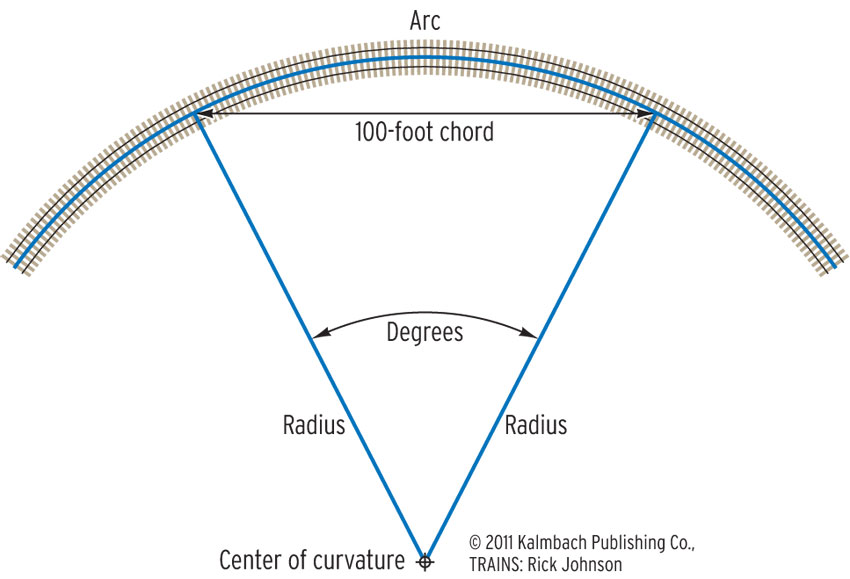Q This is a follow-up question to one in the July 2010 issue about the three air hoses on locomotives (page 58). I saw engines in the ’70s and earlier with four hoses and some with only two. Why the difference?— Dan Mirabelli, Neenah, Wis. A The two-line m.u. setup was generally for 14EL-equipped units. […]
Section: Ask Trains
Measuring track curvature

Q How do railroad design engineers measure track curvature in the United States? I believe it has something to do with measuring the degrees between two radii of a circle having the track as the arc length, but I don’t fully understand how it is measured, or from where exactly on the tracks the radii […]
Ask Trains from December 2010
Q I’ve read that when some railroads sent their steam locomotives in for a complete overhaul, they changed the main drivers to a disc type. Why would they do this?— Alex Jamieson, Chatham, Ont. A Changing to disc-type drivers was done on a case-by-case basis. The older style spoke drivers had a tendency to break […]
Ask Trains from September 2009
Q How do railroads figure how much power is necessary for a train?– Richard Panarese, Mesa, Ariz.A Railroads determine power needed for a train based on the route, and the train’s weight and priority. BNSF, for instance, considers the “horsepower per ton” required based on what officials call the train’s “transportation service plan.” The transportation […]
Ask Trains from May 2009
Q In March Trains, an article on the demise of semaphore signals on the former Monon [Page 14] mentioned that CSX was doing away with lineside pole lines and their maintenance. It said the new system will use Electro Code, a system where signal communications run through the rails. How is this done?– Richard K. […]
Lionel diesel horns
Q: I’m having problems with my postwar Lionel diesel horns. One is in a no. 2343 Santa Fe F3 and the other is in a no. 2331 Virginian Train Master. Both locomotives are in like-new condition, and though I know I can buy a replacement horn, I’d like to keep them original and get the […]
Ask Trains from August 2005
Q Can you please explain the visual and mechanical differences among EMD’s SW-1500, MP15DC, and MP15AC switchers?– Andrew J. Jones, Wigan, England A Electro-Motive’s SW1500, MP15, and MP15AC were all 1,500-hp switchers, but the later MP series were significant upgrades to the older SW models. The SW1500, built 1966-1974, used a non-turbocharged 12-cylinder 645E engine. […]
Ask Trains from December 2005
Q I saw an unclear photo of a Pennsylvania steam locomotive identified as an S2, with the number 6200. Two things caught my eye: the 6-8-6 wheel arrangement, and the absence of any visible cylinders or driving rods. What can you tell me about it?– J.H. Lehman, Dayton, Ohio A The 6200 was a one-of-a-kind […]
Ask Trains from November 2005
Q I saw a big tank car (DUPX 29744) at Wilson, N.C. It was quite long, with four trucks. What products do these cars carry? How many are there, how heavy are they, and why so big? – D. Wescott, Wilson, N.C. A It is a 43,800-gallon, 526,000-pound (gross weight) car owned by DuPont, in […]
Ask Trains from October 2007
Q On many Union Pacific refrigerated boxcars, the reporting mark “ARMN” appears below the UP shield. What railroad is that?– Kevin Margan, Madison, Wis. A Normally any reporting mark not ending is “X” indeed stands for a railroad company (“X” signifying privately owned cars), and UP, like several Class Is, still uses initials of railroads […]
Ask Trains from November 2006
Q On the front of a typical diesel locomotive are six “hoses.” Please define their purpose. Further, above the coupler is what appears to be a shorting hose. What is that? – Howard Beard, New Port Richey, Fla. A What you’re seeing is two sets of three hoses that are part of a train’s air-brake […]
Ask Trains from May 2007
Q On page 57 of January TRAINS is a magnificent photo of a BNSF train about to hit the diamonds at Savanna, Ill. What intrigues me is thepattern on the railheads within the diamond. They appear to be deliberate and not just from wear. Is there a reason for them, or are my eyes deceiving […]
